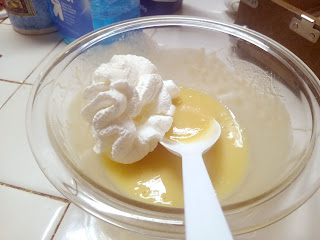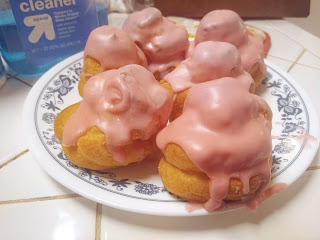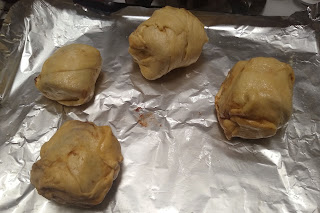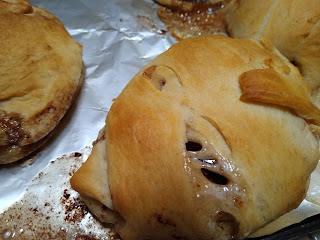Even when I'm evading the holiday, Christmas always makes me want to make Fanny Cradock recipes. We have made every species in her Christmas bird episode (see the chicken here, the duck here, and the turkey here). And today, we make the most dreamy way to make luxurious desserts while barely spending any grocery money! If you think this is an exaggeration, this is literally everything we are using for today's recipe. (Well, everything except the ingredients for the filling and icing at any rate.)
 |
| Now that a dishwasher has entered my life, I can measure out ingredients without handwashing a pile of tiny bowls. |
Today, we turn to her episode on petits fours to make this!
|
Choux Buns 2 oz butter* 4½ oz water (½ cup plus 1 tbsp) 2½ oz self-rising flour† (½ cup plus 2 tbsp) 2 eggs If you have a pot that you can use an electric mixer in without scratching it, use it. Melt the butter in the water in a small pot over medium heat, then turn up the burner until it boils very hard. Dump in the flour all at once, keeping the burner at high heat. When the boiling water starts to bubble right over the flour (this should only take a few seconds), remove from heat and beat hard until smooth. Switch to a hand mixer if it won't scratch your pot. Add the eggs, one at a time, beating the mixture very hard until completely smooth after each one. Put the dough in a piping bag with a wide tip (one-half to one inch). Leave it out at room temperature until it cools completely. If you don't, you will have hot goo in the middle of your buns. When the choux paste is cold, lightly grease a cookie sheet. Move an oven rack to the top of the oven and heat it to 450° (yes really). Pipe the dough out into the shapes you desire, leaving plenty of room for expansion. Use a knife dipped in cold water to cut the dough off of the piping bag, re-dipping it in cold water whenever the dough sticks to it. You can also use the knife to reshape any buns don't come out like you wanted. Bake until darkly colored, which can be about 12 minutes if you piped out little ones or even thirty minutes if you made big ones. For the filling, make any custard recipe you like. You can fold whipped cream into it if desired. When the custard and the buns are cooled, cut the buns open and fill them. It'll be easier to make tops stay on after filling them if you leave a little hinge instead of cutting them all the way off. To ice the buns, mix powdered sugar, a tiny pinch of salt, vanilla, food coloring, and enough water to barely make it thin enough to slowly pour out. You want a very thick glaze. Spoon it over the buns. *Apparently unsalted butter is an American-only thing, so I added a pinch of salt to make up for its absence. †Don't blame me for the added baking powder, Fanny Cradock wrote the recipe. Source: Fanny Cradock Cooks for Christmas: Petits Fours, BBC, 1975
|
Today, we are making one of the sacred recipes of French cooking canon: choux paste (or choux pastry if you want to sound proper with two rolled R's). As with all French recipes made by anyone outside of France, there are people who swear that this is a super-ultra-rare-special technique and don't you dare change it or else Escoffier and Careme will come from the grave and swat you. If you delve deep into the world of people who unironically use the word "gastronomy," you will find people can't even give the recipe entirely in English (using French names for the various steps of it is just so much more authentic). Google Translate even refuses to give an English translation of the word "choux" when you're looking up baking terms.
 |
| Oh. Choux is the French word for choux. Thank you, robotranslators. |
But if you took French in school and remember the grocery store vocabulary words, you will know that "choux" means cabbages, and therefore "pâte à choux" means "cabbage paste." Apparently if you shape it into balls, the buns kind of look like cabbages after expanding in the oven. But "cabbage pastry" just doesn't have the je ne sais quoi that "choux pastry" does.
On a related note, at some point after Miss Leslie gave recipes for "puff paste," "the best plain paste," and suchlike in the bestselling American cookbooks of the 1830s, we all decided that we were making pastry instead of paste. It is acceptable to make paste if it's in other languages (pasta, pâte, etc). But a long time has passed since anyone lined a pie pan with paste in English.
 |
| Like Fanny Cradock says, just dump all the flour in and wait until the boiling water seethes over it. |
Because it's a Very Traditional French Recipe, I saw a lot articles that made choux paste seem like a super-advanced technique that requires a thermometer, years of practice, and several hours of sweating over a hot stove to get right. But if you ignore the cultural heft and look at the recipe, anyone who can make white gravy can make choux paste. The only thing that felt weird to me was using water instead of butter. I've never thought about it, but it seems that nearly every baked dessert recipe uses milk instead (cue the long list of exceptions I totally should have named).
After a really hard beating with a spoon to bash out the flour lumps, we have what's basically a unpourably thick white gravy. It smelled exactly like an extra-buttery pot of mashed potatoes.
At this point, Fanny Cradock tells us that we would discard the spoon if we're clever and get out an electric mixer. And while I may be clever(ish), I also don't have pots that can withstand an electric mixer without getting ruinously gouged. I was afraid the egg would immediately scramble on contact with the hot paste, but dumped the egg in anyway. Fanny Cradock didn't have any problems with curdled eggs, and she did this on TV. Sure enough, instead of cooked egg lumps, we got what Fanny Cradock called "the globule stage." Fanny Cradock really does make this recipe sound enticing as she mutters about "nasty little lumps" while wielding an electric mixer that scrapes and grinds into the pot.
It's a lot harder to get everything beaten smooth when you're using a spoon instead of an electric mixer. You really do need to beat the globules very hard before everything finally mixes together. Fanny Cradock was right when she said to just think of someone you never liked but you're too well-bred to say anything so you take it out on your cooking. But if you have stainless steel pots, I definitely recommend using one and getting out the mixer. Even if you have to handwash dishes including mixer beaters, you'll still be glad you did.
After all this hard beating, we've basically made a batch of gravy that you could sculpt like modeling clay. I don't get why people babble on about choux paste like it's a maddeningly difficult French recipe. The only hard part was the excessive arm workout. And now, as Fanny Cradock tells us, we need to let it get absolutely cold. And so, I put it into my piping bag and waited. This stuff held heat unexpectedly well. Every time I thought it was cold, I would squish it and find that some of it was still warm in the middle.
The last time I made choux paste, it was in cooking class. Since we had to make everything in a short time, I did not have time to let it get cold. Nor did the official recipe in the cooking textbook tell me that I should. As a result, all of my choux balls were full of the "surplus goo" that so infuriated Fanny. We ended up frantically picking out all the hot dough in the middle before filling them with whatever the stuffing was that time. That dough browned on the outside, but it never baked. It just got hot instead. At the end of class, one of my classmates tried dropping some of the extra dough in a hot frying pan where it turned into a big splat of hot goo with a browned exterior. The danged stuff absolutely refused to turn into baked bread no matter how much heat we put on it. But since I have no end-of-class deadline this evening, I just left this out on the countertop and until it was as cold as the drafts blowing in through the walls.
Fanny Cradock makes these three-step shaped buns, though a quick image search shows that people these days make ball-shaped ones instead. You can see how badly I messed up the last one when I was trying to get a bun's worth of a dough out of a now-empty bag.
Fanny Cradock tells us we may not believe her when she says to bake these at gas mark 8 on the top oven rack. I looked up a conversion chart, and apparently gas mark 8 is around 450 Fahrenheit or 230 Celsius. Fanny Cradock was right-- I didn't believe her. But even watching her online with about forty years between her broadcast and you, it's hard to argue with her glare. And so, I heated the oven to the hottest temperature since the pita bread. I then spent the entire time these baked anxiously hoping the bottoms of these things wouldn't turn to charcoal. I can live with baked failures, but I hate when they leave a smell that I have to live with for the next week. As a result, I took these out a bit earlier than Fanny Cradock might have. It's easy to admire the lovely golden color, but I was instead terrified that these things were full of hot goo.
I would say that you should double this recipe if you're making these
for a lot of people, but these things expand a lot in the oven. So
instead, just make them a lot smaller than you think, and this
seemingly-small amount of choux paste will be plenty. Have a look:
They do look kind of like little cabbages, don't they? Or at least, they would if I had made balls instead of little three-tiered buns. Here is a better view of just how much bigger they got. These things didn't rise in the oven, they inflated.
The biggest surprise lay underneath these puffed-up creations. Despite spending nearly twenty minutes in an oven hotter than I ever bake at, they were not even close to burnt on the bottom.
We left these until they cooled off, and then cut them open to reveal...
Perfect hollow things ready to receive whatever we want to stuff in them! In full disclosure, some of them didn't have that perfect hollow space in the middle. We had to press the inside of these open with a fingertip. But we weren't picking any unbaked goo out of these, nor were we cutting anything out of them. We merely pushed the little layers of perfectly goo-free bread to the sides.
As for the custard, Fanny Cradock has a recipe for it and actually gives the amounts on camera. This is a rare departure from her usual way of telling us that "the recipe's in the booklet." However, her recipe uses egg yolks. I wasn't about to throw out egg whites, so I just made the recipe for pecan pie with extra vanilla and without pecans.
We are then directed to fold in whipped cream. I didn't think to buy a carton of cream, but one of the people in the house has taken to keeping a can of the stuff on hand for medicinal ice cream.
 |
| Don't think of it as Redi Whip. Think of it as crème fouettée en boîte. |
Fanny Cradock cuts her cream buns open very low, leaving a lot of unfilled space on the top of each one. I did the opposite, making these more like custard mugs with edible lids. Also, these things are a lot more fragile than they look on Fanny Cradock's show. She makes it look like you just saw them open, but in reality you have to be very careful with the knife lest they squish.
I thought this filling was very runny, but so was the custard she used on TV. And apparently that's just like what we could get in France if we traveled. On a related note, I think perhaps our American fascination with France is so severe because so few of us go there. France probably has a lot less of a mystique when you can just cross the English channel in an afternoon. Maybe American culinary snobs wouldn't try so hard to use French words whenever possible if you could just go to France for a weekend instead of hearing secondhand myths about their exquisite cooking--- er, cuisine.
Back to filling our buns with custard, I am very happy that I made just the right amount. All of the cream buns got happily filled, and the bowl got nearly emptied. I didn't run short, nor did I have a lot of unused extra. It felt almost as satisfying as when your cupcake batter exactly fills your cupcake pan.
I thought about making cinnamon icing for these but decided to keep it simple. So these just got powdered sugar and water- with a pinch of salt and a splash of vanilla for flavor. We only had red food coloring on hand, so these got iced with pink. I do like how the tops fit so perfectly back on after inserting the custard that you can't see the cut line under the icing.
If you're going to make these, you probably want a much thicker custard filling than these contain. Fanny Cradock, ever prepared, brings out a quote from some famous person or another (she kind of mumbles over the name) who says that "To eat cream buns that are properly made you should be sitting in your bath in your altogether." She then helpfully informs us that of course that's not suitable for parties. As far as I can tell, she made up that quote to compensate for a runny custard cream. I looked around online and couldn't find anyone ever saying anything about eating cream buns in the bath. With that said, it did get all over my shirt the first time I ate one. Maybe I should have eaten one while I was in a bathtub.
When they were fresh, the dough tasted kind of eggy. I know a lot of people worry that choux buns need food-grade humidors to keep them at their best, but I just put these in the refrigerator on an open plate. They tasted a lot better when they were cold. When they were at room temperature, the somewhat eggy taste of the buns clashed with the custard and the icing. Everything harmonized after they refrigerated.
The choux buns, like a pie crust, are relatively flavorless on their own. That means you can put whatever you want in them. With custard and icing, they tasted just like something from one of those doughnut shops that actually makes them fresh instead of trucking them in. So if you make these, definitely put them in the refrigerator.
The verdict from others in the house: "Pretty good, but not mind-blowing." I did, however, get a lot of complaints that the filling was too drippy. So if you make these, you'll want to cook your custard a lot thicker than I did.
But these really are very easy to make if you already know how to make white gravy. And they really are very cheap to make. The only part that took a long time was waiting for the paste to completely cool off before piping it out.
In sum, follow Fanny Cradock and you can never go wrong! But after all these custard-filled delights, you may have difficulty getting into your clothes.













































